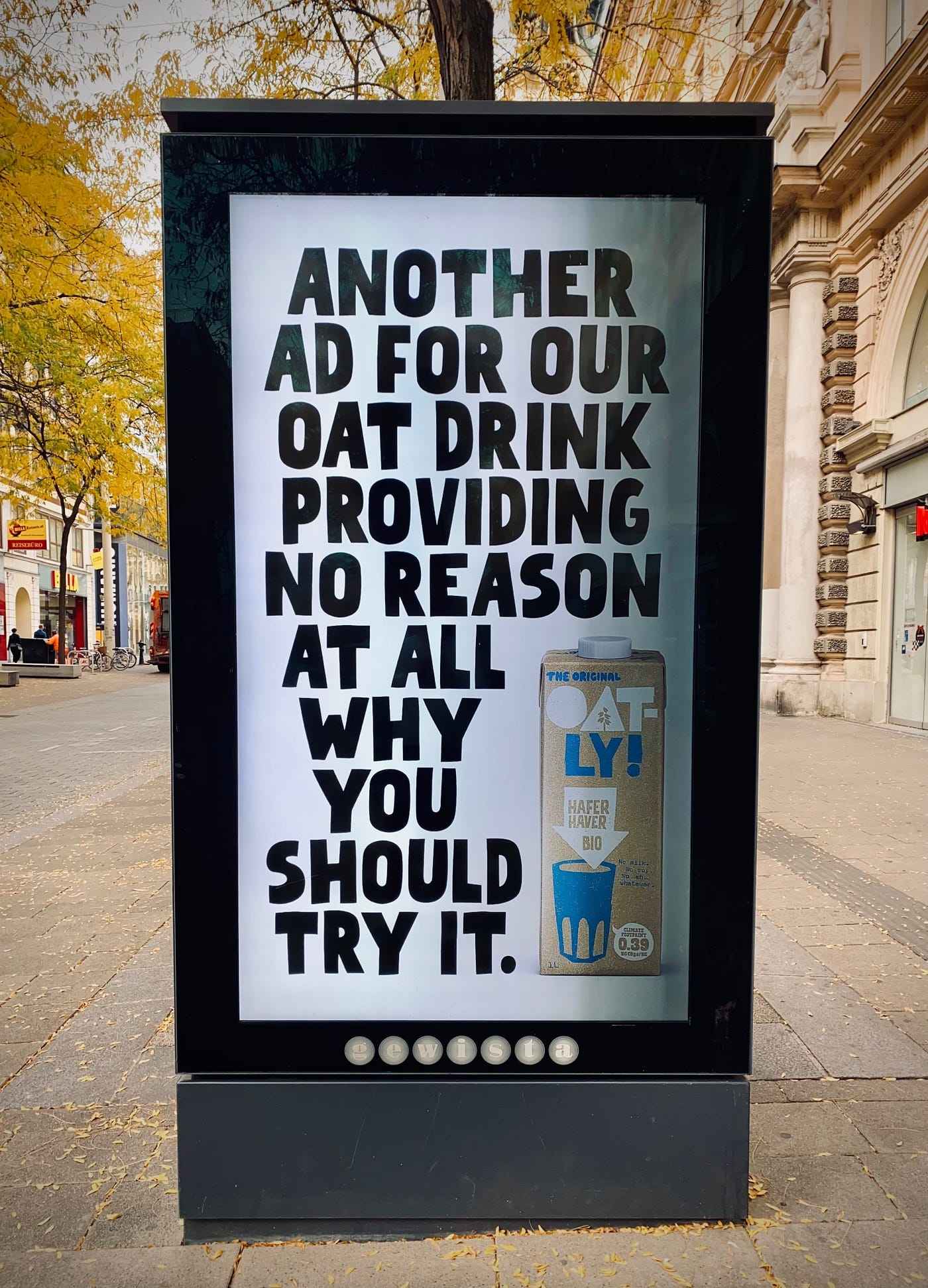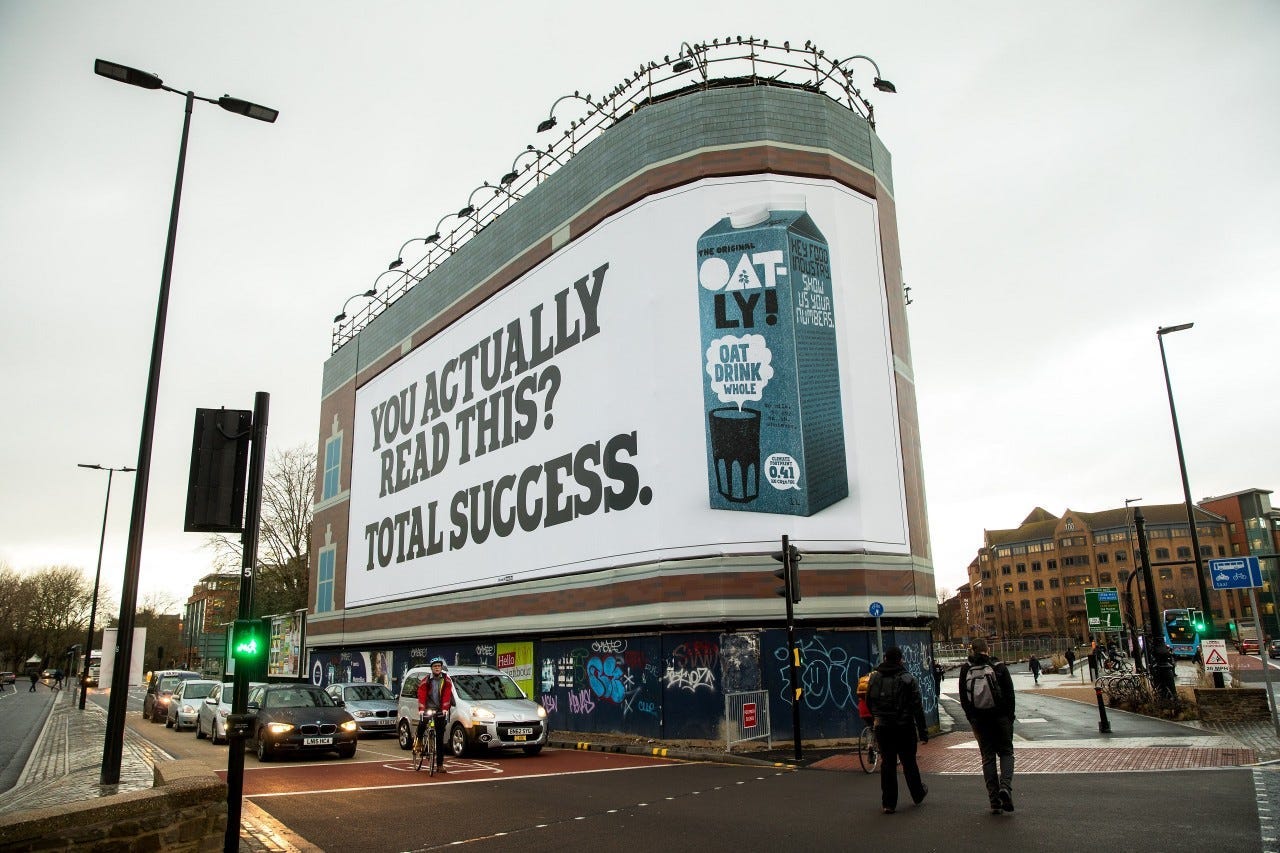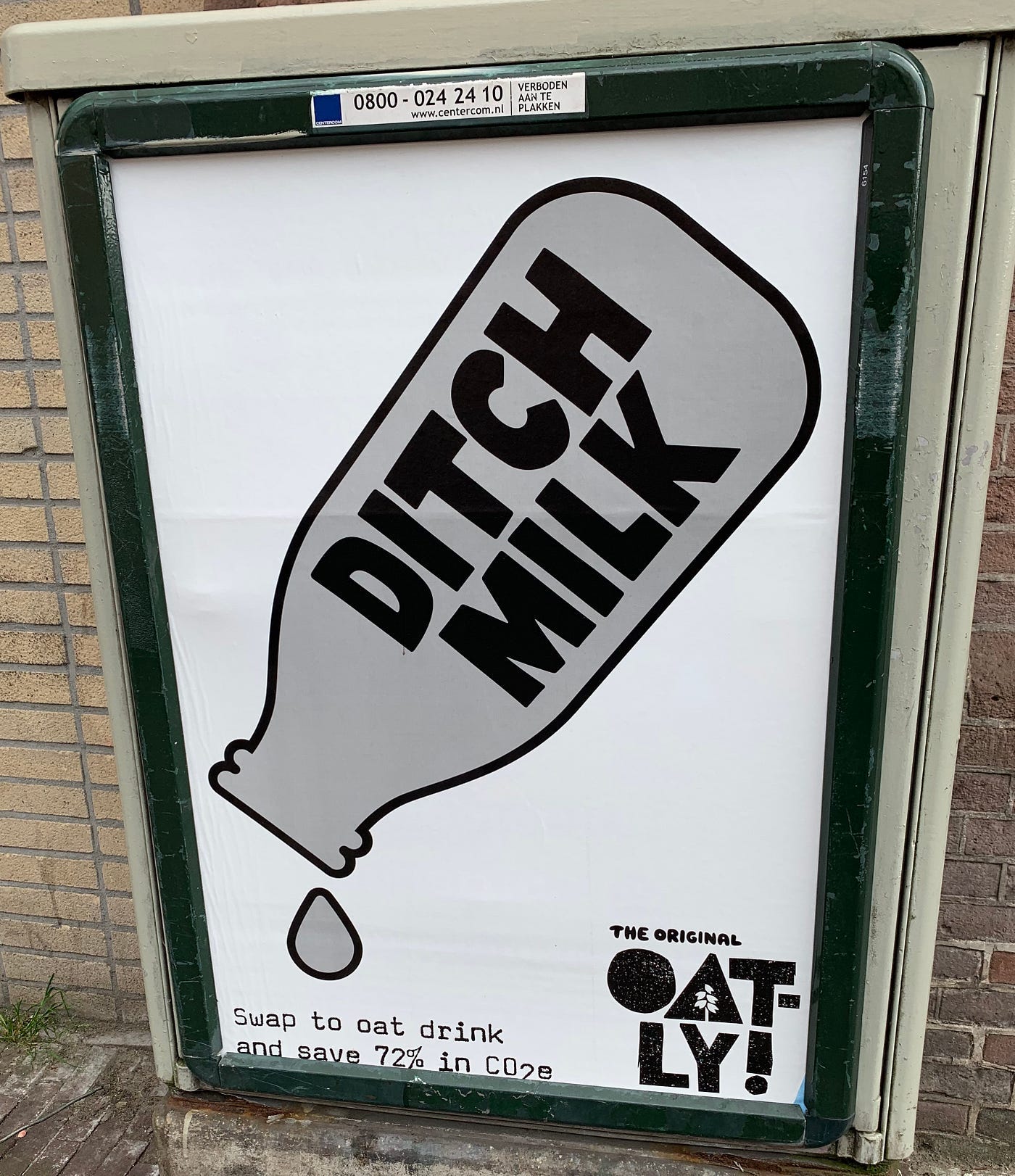Why Oatly’s Anti-Marketing Approach to Marketing Works
How Oatly created a brand that’s as clever as the concept of turning oats into milk
One of my earliest fascinations with marketing was the Got Milk? campaign of the 1990s. I didn’t realize it was marketing at the time — I just liked to see which of my favorite TV characters or figure skaters would show up in the TV Guide wearing a milk mustache. The campaign cemented itself into the marketing hall-of-fame by creating a pithy tagline and compelling message that made millions of people pay attention to a commodity: milk.
Even after years of collecting these ads and drinking milk almost daily, I still can’t name a single milk brand. For years, I grabbed whatever milk was organic and 1%, without any brand recognition or loyalty.
But since I switched to oat milk, there is only one brand I’ll buy: Oatly.
Originally, Oatly stood out to me for its superior taste and its scarcity. I could barely find it in San Francisco for many months, so when it turned up again I started buying it in bulk.
It’s not just Oatly’s taste that makes it remarkable (although if it weren’t good, nothing else would matter). The Oatly marketing team has been working overtime to create a brand that is as clever as the concept of turning oats into milk. They’ve taken the marketing playbook that says brands need a concise message highlighting product benefits in a friendly, approachable tone— and they’ve completely thrown it out the window.
Oatly takes a decidedly anti-marketing approach to marketing — and it works.
The Anti- ”Got Milk?” Advertisement
If you’ve ever seen an Oatly ad in the wild, you might think: wait, they’re trying to sell oat milk? It’s as if the marketing team were made up of people who hate marketing.
The approach makes sense for Oatly. If Oatly is trying to be the opposite of milk, why wouldn’t they take the opposite approach to marketing, and create the antithesis of the Got Milk? ad campaign? The Got Milk? campaign created ads where celebrities made milk sexy. They were ads everyone wanted to collect, but ultimately left you with zero brand recognition or loyalty.
Oatly doesn’t want to be sexy. So, their ads don’t need to be eye-popping, attention-seeking, or loud in the same way marketers are taught is necessary to get our brand noticed. Unlike traditional advertisements, Oatly ads don’t talk about product benefits. They are self-deprecating and often self-referential, poking fun at the fact that they’re even taking the time to plaster a billboard with their image, because who stops to read a billboard?
Oatly distinguishes itself by tossing aside the rules of marketing and breaking the fourth wall between marketers and consumers. They push the boundaries of advertising like they’ve pushed the boundaries of milk (and oats).
Copy That Reads Like a New Yorker Article
There are two things that stand out to me when I look at a carton of Oatly: the amount of copy and the tone of voice. The copy is verbose, witty, and sassy. It also cheekily makes fun of other marketers for using exaggerated language to describe how great their products are. They even go so far as to call themselves “boring” — not something any marketer would admittedly call his or her own product in public!

Other than ingredients and cooking instructions, I don’t think I’ve ever taken the time to read food packaging this closely. Reading a carton of Oatly is like reading Daily Shouts in the New Yorker: self-deprecating, culturally relevant, and flippant. A carton of Oatly has personality for days!
Oatly creates marketing that, based on the sheer amount of copy and dismissive tone, no one should want to read or pay attention to. Yet, anyone who does take the time to read it recognizes and appreciates the brand because of its unique perspective and voice.
This copy does two things: It creates an engaging experience for consumers while we’re enjoying the product, and its wittiness wins consumers over, creating further brand loyalty.
Now, neither of these things would happen if Oatly were a subpar product. But because the product is consistently delicious, the packaging takes Oatly from a commodity to a recognized and sought-after brand.
Cultural and Contextual Relevance Over Product Benefits
When I first saw an ad for Oatly, I was on vacation in Amsterdam. At a bus stop was a large image of an overturned glass milk bottle with the phrase “ditch milk.” Oatly could have stopped there and gotten their point across. But they went a step further by adding a clever statistic at the bottom, almost as an afterthought: “Swap to oat drink and save 72% in CO2e.”
Not only did Oatly tie their brand to an important cause like climate change, but they also superbly targeted this message to their Amsterdam audience. This messaging probably wouldn’t have worked in traffic-laden New York City or Los Angeles. But in Amsterdam, where nearly ⅔ of urban transport is by bike, Oatly tapped into the most important product benefit for this local audience: sustainability.
I got a look at how different Oatly’s approach to marketing to New Yorkers was when I was stuck in traffic in Manhattan. Oatly has continued its hyper-local, contextually-relevant out-of-home advertising by placing witty ads on NYC buses that reference the ad will be “driving away soon.”
This strategy gives Oatly brand recognition, even though it doesn’t mention what the product actually is, save for a product image. But in NYC where quick wit and traffic humor can garner a chuckle out of even the busiest New Yorker, creating awareness for the brand name itself may be enough for this bus ad to be a success.
They garner the appreciation of local consumers by being relevant, even if they haven’t spent their ad real estate talking about the product itself.
Takeaways
It’s worth mentioning one more time: if the Oatly product was subpar, none of this marketing would make any difference.
Because Oatly is delicious, the brand’s voice adds to the product’s allure, and its anti-marketing marketing strategies stand out as engaging and persuasive to an existing fan. Oatly has brilliantly captured what works for its target market — New Yorker-style diatribes that would land in the “High Brow & Brilliant” quadrant of New York Magazine’s Approval Matrix.
Would I feel differently about their marketing if I had never heard of Oatly, or if I weren’t a marketer? It’s possible. But as an Oatly fangirl and a marketer, their marketing strategy makes me an even more loyal and excited customer.






